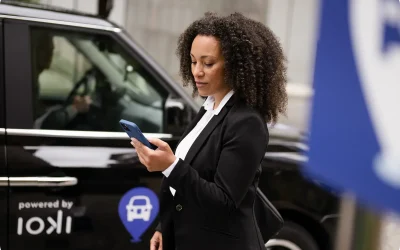For many people, the term autonomous driving still conjures up wild associations of futuristic cities like in the film “The Fifth Element”, where hovering vehicles transport passengers from A to B without a driver. Reality, of course, looks different: What is the current status of autonomous driving in Germany?
The applications are still very much shaped by research and development. However, “shuttles” in particular – small buses that are mostly designed for completely driverless transport – are on the rise. They are being used for public transport in rural areas and already provide real added mobility value in these regions.
It is not only the autonomous shuttle in Bad Birnbach that has set new standards in automated public transport already in 2019. The EVA shuttle, which has been operating on the streets of Karlsruhe since April 2021, is also an absolute novelty in the German transport landscape. For the first time, ioki has combined on-demand bookings with an autonomously driving shuttle service. How were these highly complex components being connected with each other?
The necessary ecosystem for successful autonomous driving is complex: sensors, the vehicle, the control software and many other factors play a role. At ioki, we have taken a very clear position here and remain true to our core focus. We create routes for vehicles in a fleet that needs to move as efficiently as possible – in this case, driverless vehicles. In the EVA project, the vehicle itself is the direct recipient of our routes for the first time. The complexity is primarily hidden in two main topics:
On the one hand, the vehicles are individual prototypes and far away from standardised norms. So, it is not only the communication technology and the data format that need demand customised solutions here. There are also fundamental requirements that must be met by the vehicle, e.g., vehicle safety. For this purpose, we have developed an extension of our platform that takes over the translation service from the software to the vehicle.
On the other hand, standard map material and routing services have been designed for humans in normal vehicles. The vehicles we deal with in Karlsruhe are far from behaving like human-driven vehicles. They drive at slow speed and other movement restrictions. In addition, there are very individual licensing conditions that mean further geographical limitations. In order to master this task and to be able to guarantee the routes, the bundling of passengers and the calculation of the arrival time, a proprietary routing technology was developed that takes 100% of the so-called operational design domain of these vehicles into account.
Were there any particular obstacles in the development of the technical interface?
The complexity of the overall system is enormous. One of the biggest hurdles was certainly to develop and test a vehicle under the contact and travel restrictions of the Corona pandemic. Software from three companies comes together, which only in interaction allows a demand-oriented passenger transport. Each of these components is brand new and at the forefront of technology.
Is the combination of autonomous vehicles with on-demand mobility solutions the key to the public transport of the future?
It’s not the master key, but a promising approach. Should we replace the Berlin S-Bahn ring with 200 shuttles? Probably not. That wouldn’t do any good, neither the city nor the people. Are there use cases in which a driverless on-demand solution can bring huge added value? Yes, absolutely: Even though driverless vehicles remain more expensive to buy, they will essentially reduce operating costs. This will especially benefit areas that have had a weak public transport infrastructure.
Let’s assume you had a glass sphere with which you could predict the future: How will the integration of autonomous driving into public transport continue to develop?
This varies from country to country. Not only the legislation for the technology alone, but also the laws on transport play a major role here. If countries manage to formulate a good balance of economic efficiency for operators and holistic mobility concepts into their laws, driverless vehicles will support public transport exactly where it is weak today – just as we are already doing today, only with more mature vehicles.



